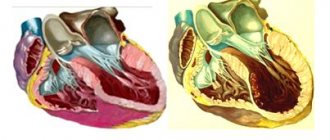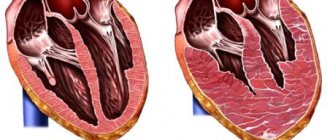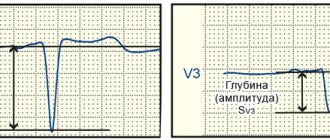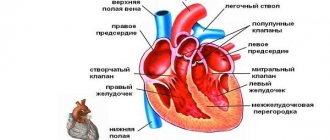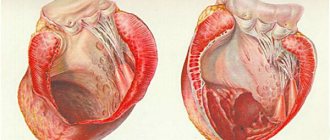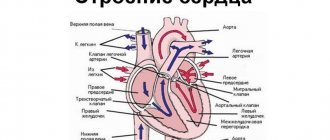The enlargement of the left ventricle of the heart is associated with the adaptation of the organ to external and internal factors. In a child, the problem often arises due to congenital defects, and in an adult due to the development of hypertension due to the abuse of bad habits and obesity. Such a deviation is extremely dangerous, as it causes disruptions in hemodynamics (blood flow), leading to other complications. The essence of treatment for a hypertrophied (enlarged) ventricle will be the use of drugs to eliminate the causative factor and facilitate the work of the heart.
Process Features
The left ventricle is enlarged only due to its hypertrophied wall, which leads to distortion of the interventricular septum of the heart. Its thickening can be uniform or localized. The interior space is not modified.
Experts distinguish 2 forms of pathology:
- Concentric hypertrophy occurs under the influence of high pressure.
- The eccentric form develops due to congestion of the ventricle with a large volume of incoming blood.
If a person has an enlarged left ventricle of the heart, then he should remember the general list of consequences of this pathology:
- cardiac ischemia;
- stroke;
- asystole (cardiac arrest);
- expansion of the aorta;
- irregular heartbeat;
- loss of consciousness;
- heart failure;
- stenosis of the coronary arteries.
Complications are associated with the gradual loss of elasticity of the left ventricle due to its hypertrophy. The pressure inside the heart will increase, causing severe disruptions in hemodynamics. Overgrown tissue can also begin to compress the coronary vessels, causing disruption of myocardial nutrition.
Symptoms of pathology
Atrophy of the left ventricle of the heart can be identified by the clinical picture characteristic of this pathological process:
- Developmental delay. The problem is characteristic of the congenital form of the disease. The patient's tissues do not receive the required amount of necessary substances for full growth, as a result of which developmental retardation is observed.
- Dyspnea. Atrophic changes in the left ventricle disrupt blood flow, which is why the body does not receive the required amount of oxygen. This phenomenon leads to ischemia of internal organs and tissues. To correct the situation, the respiratory center receives a signal to increase the amount of air inhaled. Shortness of breath is a consequence of this entire process and is designed to increase the concentration of oxyhemoglobin in the blood. It is a combination of hemoglobin and air in red blood cells.
- Edema. They represent the second clear sign of acquired ventricular atrophy and indicate heart failure. Edema occurs due to stagnation of venous blood, since the heart cannot fully perform its functions. Initially, the problem begins in the lower extremities. As swelling progresses upward, it can be concluded that heart failure is worsening.
- Irregularities in heart rhythm. Chronic lack of nutrition leads to the death of cardiomyocytes. They perform not only the functions assigned to them, but also regulate the heart rhythm. With atrophic changes in the myocardium, the number of cardiomyocytes is reduced, which leads to disruptions in the process of heart contraction.
Causes
The reasons for the enlargement of the left ventricle of the heart can be seen in the table:
| Names | Peculiarities |
| Hypertension | Persistently elevated blood pressure is considered the main reason why the left ventricle dilated. It usually begins to increase after several years of decompensated hypertension. The cause concerns virtually 90% of cases of myocardial hypertrophy |
| Cardiomegaly | With cardiomegaly, the heart is enlarged to the left, but not many people understand what this means. Unlike myocardial hypertrophy, this disease is characterized by an increase in the mass of the organ due to the growth of its muscular wall and 4 chambers, and not 1-2. Pathology appears from birth or is acquired over time under the influence of other factors |
| Sports activities | Professional athletes train constantly to achieve their goals. Excess muscle mass requires additional blood flow. The heart has to contract more often than expected in order to compensate for the overload, which leads to its increase |
| Developmental defects | Anomalies in the structure of the heart can be congenital or acquired over time under the influence of other factors. The first group is more often detected in newborns, and the second in adults. In most cases, there are defects of the valve apparatus. Violation of their functions leads to an increase in the load on the cardiac chambers. |
| Ischemia | With a lack of nutrition to the heart muscle, disturbances in the relaxation phase of the myocardium occur, against the background of which the left stomach grows. |
| Cardiomyopathy | Enlargement of the left ventricle occurs due to hypertrophic or dilated cardiomyopathy. The cause is usually pathological changes (dystrophic, sclerotic) of the myocardium. |
The following factors may increase the risk of developing myocardial proliferation:
- night apnea (short-term cessation of respiratory function);
- menopause;
- irregular heartbeat;
- alcohol abuse;
- smoking;
- obesity;
- frequent stress;
- kidney and respiratory diseases;
- endocrine disruptions.
Mild hypertrophy is often detected in women during pregnancy. The heart has to pump more blood than usual, so the process of myocardial growth begins. It stops when the child is born.
What is a hypertensive heart?
Have you been struggling with HYPERTENSION for many years without success?
Head of the Institute: “You will be amazed at how easy it is to cure hypertension by taking it every day...
Read more "
In specialized literature, the term “hypertensive heart” is sometimes used. What it is? This term is not always interpreted in the same way by cardiologists and therapists. As a rule, when referring to “hypertensive heart”, they mean changes in the structure and function of the heart muscle that occur as a result of increased blood pressure (BP).
What can cause such changes and how their negative impact on the functioning of the cardiovascular system can be compensated for – we will look into it below.
Pathology of the heart muscle in hypertension
Hypertensive heart is usually used to denote complex changes in the heart muscle that affect both its structure and the mechanism of contraction.
Such changes usually develop against the background of hypertension or arterial hypertension. A prolonged increase in blood pressure leads to an increase in the frequency of myocardial failures. If you leave the situation to chance, there is a high risk of developing heart failure.
Causes and risk group
Doctors use the concept of “hypertensive heart” when spasms of the heart muscle are systematically observed.
It will be much easier to understand what cardiac hypertension is after analyzing the reasons that cause it:
- deficiency of microelements (primarily magnesium);
- atherosclerotic changes in blood vessels;
- infectious lesions;
- inflammatory processes (can develop with infectious diseases of a bacterial nature).
Myocardial hypertension can also develop against the background of age-related changes in the heart muscle. In older patients, the risk of pathology increases.
The likelihood that a person will develop hypertension with heart damage increases if:
- over 55 years of age;
- lack of microelements (K, Mg) in the diet;
- diabetes mellitus;
- excess body weight;
- physical inactivity;
- constant stress;
- alcohol abuse;
- smoking.
Premature babies and newborns whose mothers took steroid drugs or suffered an infectious disease during pregnancy are also at risk.
The causes of the development of cardiac hypertension include: bad habits
Stages of development of cardiac hypertension
Hypertensive heart disease is a pathological condition that develops gradually. In the early stages of development, changes are almost invisible and difficult to diagnose. The further the process goes, the easier it is to detect the disease, but the more difficult it is to stop the symptoms and bring the heart back to normal.
Hypertension with primary damage to the heart goes through the following stages:
- At the first stage, there are no serious pathologies. Diastolic dysfunction is noted, which becomes the cause of further development of the disease.
- At the second stage, changes in the morphology of the heart are noted - the left atrium increases in size. The patient experiences disruptions in the functioning of the cardiovascular system: fatigue, shortness of breath, and sometimes loss of balance. Heart pain due to hypertension can already appear at this stage.
- At this stage, hypertension of the left ventricle of the heart develops - the heart muscle increases in size. Against the background of myocardial hypertrophy, the risk of heart attack increases.
- The fourth stage is hypertension with heart failure, which can be aggravated by coronary heart disease. Blood pressure changes uncontrollably, hypertrophy of the heart muscle and the resulting functional changes greatly reduce the effectiveness of most drugs.
As can be seen from this list, the most serious pathology is left ventricular hypertension. What it is is not difficult to understand: the heart muscle, which is responsible for the systemic circulation, increases in size. Its normal functioning is disrupted, which leads to an increase in blood pressure, which is very difficult to control with medication.
Why do you feed pharmacies if hypertension is afraid of the usual like fire...
Tabakov has revealed a unique remedy against hypertension! To reduce blood pressure while preserving blood vessels, add to…
The disease does not always manifest itself in the initial stages of development
Important! Along with left ventricular hypertrophy, hypertension of the right ventricle of the heart can also develop. In this case, the pulmonary circulation suffers, which is manifested by difficulty breathing, chest pain or swelling.
Main symptoms of hypertensive heart disease
Changes in the heart during hypertension manifest themselves gradually and always in different ways. In the early stages, they can be detected by sudden changes in blood pressure that do not go away even after taking medications.
The list of symptoms of “hypertensive heart” includes:
- pain in the right hypochondrium, radiating to the left side (can reach the stomach, arms, lower back);
- pain under the sternum;
- breathing problems (difficulty, shortness of breath);
- increased fatigue;
- swelling of the lower extremities;
- anxiety;
- drowsiness during the day and problems sleeping at night;
- sweating, etc.
The heartbeat in hypertension becomes rapid, but arrhythmia is often observed.
The intensity of their manifestation depends on the degree of damage and the nature of pathological processes in the tissues of the organ
Pathological changes also affect the emotional side. Patients often complain of depression, causeless anxiety and fear.
Diagnosis of pathological changes
Effective diagnosis is the guarantee that pathology will be detected in the early stages, when changes in the structure of the myocardium have not yet become irreversible. To do this, if you detect the signs described above, you need to contact a specialist.
At the initial stages of diagnosis, analysis, palpation and auscultation of the heart are performed:
- On palpation, a shift of the impulses to the left and down is noted.
- Auscultation in hypertension usually reveals systolic murmurs at the apex of the heart.
- Heart sounds also change in hypertension. At the initial stage, the first tone above the apex intensifies, but as hypertrophy increases, it begins to weaken or is heard split. The prevalence of the second tone is considered as one of the diagnostic signs.
Differential diagnosis includes:
- general blood analysis;
- general urine analysis;
- tests for the content of various substances (glucose, potassium, magnesium).
ECG records the electrical activity and rhythm of the heart, the level of blood supply
To detail the clinical picture, additional studies are carried out:
- coronary angiography - to detect narrowing of the blood vessels of the heart;
- echocardiogram - to search for aneurysms and blood clots, as well as to monitor the condition of the valves;
- ECG – for recording electrical activity;
- daily (Holter) ECG monitoring – to assess heart function during the day.
Therapy and prevention of “hypertensive heart”
Conservative treatment
At the initial stages of the development of cardiac hypertension, drug therapy is used. If the diagnosis revealed the disease in its infancy, the prognosis will be positive.
To relieve symptoms and restore normal functioning of the cardiovascular system, drugs from the following groups are prescribed:
- agents that reduce the risk of blood clots (Vitamin E, Aspirin);
- long-acting beta blockers (“Propanolol” and analogues);
- alpha-blockers (Terazosin and analogues);
- ACE inhibitors, which have an antihypertensive effect.
Diuretics are also effective - for hypertension and heart failure, Furosemide, Chlorthalidone and similar drugs help remove excess fluid and salts from the body.
To achieve positive dynamics, a competent combination of several antihypertensive drugs is required
Important! Independent choice and use of medications is highly undesirable. All medications must be taken strictly as directed by the doctor, observing the frequency and dosage.
Surgical interventions
Medicines for heart failure and hypertension may not be effective enough.
In this case (if there is a risk of cardiac arrest), a decision is made on surgical intervention:
- The most common technique is cardiomyoplasty. A muscle fragment from the patient's back is placed on top of the myocardium and enhances its work. Approximately 3 months after surgery, contractions are partially normalized.
- Synchronous functioning of the ventricles is ensured by installing a pacemaker. The implanted device allows you to compensate for the deficiency, optimizing the heart rhythm.
- Another technique is the installation of an artificial ventricle. It demonstrates high efficiency, but this procedure is performed quite rarely due to its complexity.
Prevention of “hypertensive heart”
Neither drug treatment nor surgery will be effective in controlling cardiac hypertension without changes in the patient's lifestyle.
A healthy lifestyle creates the prerequisites for reducing the number of medications taken daily
For therapy to be successful, you need to:
- minimize the amount of stress;
- provide the body with adequate rest and sleep;
- give up bad habits - smoking, drinking alcohol;
- provide dosed physical activity (walking, jogging, sports).
Important! Physical activity needs to be increased gradually, allowing both the muscles and the cardiovascular system as a whole to adapt.
Recommended Diet
Important conditions for effective therapy are the fight against excess weight and proper nutrition. To do this you need:
- monitor the caloric content of food consumed;
- minimize the amount of fat in the diet;
- avoid trans fats and saturated fats;
- exclude spicy, fried and too salty foods from the menu;
- give preference to boiled and steamed foods;
- Be sure to eat fish and seafood.
By correcting the diet, the patient protects himself from the risk of developing the disease.
The diet must include:
- fresh vegetables and fruits;
- greens (lettuce and dill - first of all);
- buckwheat;
- dark rice;
- flour products with bran;
- low-fat dairy and fermented milk products.
Folk remedies
You can also fight hypertensive changes in the heart using folk remedies. The most common recipe involves using a honey-lemon mixture:
- Wash 500 g of lemons thoroughly and pass through a meat grinder.
- Add 500 ml of liquid honey.
- Pound 20 apricot grains in a mortar and mix with the honey-lemon mixture.
We eat the resulting mixture a tablespoon twice a day - morning and evening.
Thistle infusion also helps:
- Grind fresh or dried leaves thoroughly.
- Place a tablespoon of crushed leaves in a glass and pour 200 ml of boiling water.
- Leave for 20 minutes, then cool and strain.
The infusion should be drunk 3-4 times a day, 100 ml. The optimal duration of the course is 14 days.
Conclusion
Cardiac hypertension, developing gradually and hardly manifesting itself in the first stages, can cause heart failure. To avoid this, it is important to diagnose the disease in time by consulting a doctor. In the early stages, hypertension can be treated with medication, but the further you go, the higher the likelihood that it will not be possible to do without surgery.
Post navigation
Clinical picture
Left ventricular hypertrophy manifests symptoms only in advanced stages, when severe disruptions in blood circulation and cerebral hypoxia develop. Patients attribute the first symptoms to fatigue, but gradually they become more and more pronounced:
- lack of air;
- dizziness;
- pain on the left (chest area);
- increasing weakness;
- dyspnea;
- feeling of irregular heartbeat;
- loss of consciousness.
The following symptoms are considered life-threatening:
- shortness of breath developing into suffocation
- decrease in cognitive functions (intelligence, memory);
- tachycardia;
- pain in the heart that does not stop for more than 5 minutes;
- frequent loss of consciousness.
Such signs may indicate the development of severe complications. To prevent them, you must urgently go to the hospital.
Description of LVT
The heart has 4 chambers. If the organ is healthy, the blood in it flows from the atria to the ventricles. The movement of blood between the chambers is ensured by the heart valves, which open and close in response to the rhythm of the heartbeat. Due to trabeculae (chords), the elasticity of the valves is maintained.
LVDP of the heart in a child is a congenital anomaly that forms in the uterine period and is accompanied by the appearance of one or several chords at once. As a rule, this pathology does not require any treatment. But a child with an additional trabecula in the cavity of the left ventricle needs regular supervision by a cardiologist.
On a note! Trabeculae are partitions of bone or muscle tissue that form the frame of an organ. ICD 10 code – Q20.
The extra trabecula that forms in the heart is tendon tissue. Excess trabeculae are located differently to the vertical axis of the LV; they can be longitudinal, diagonal or transverse.
The most severe anomaly is transverse LVOT, as it can disrupt the heart rhythm. The diagonal and longitudinal trabecula of the left ventricle in a child are considered minor pathologies - they affect the movement of blood in the chambers.
Diagnostics
If a clinical picture characteristic of the process of proliferation of the heart chambers is identified, it is necessary to contact a cardiologist. He will interview the patient to find out about disturbing symptoms and the presence of other diseases. Then he will conduct an examination, which includes auscultation (listening to sounds) and measurement of pressure and frequency of contractions. Next, the doctor will order for examination:
- Electrocardiography (ECG) will allow you to see the following deviations: the QRS complex is deviated (to the right and forward) from its usual position;
- the degree of excitation increases (from the endocardial layer to the epicardium);
- signs of ischemic disease appear;
- failures occur during the impulse conduction process;
- the electrical axis of the heart is deviated to the left;
- the chest lead is displaced;
- partial or complete blockade of the His bundle appears.
Treatment methods
Surgical and conservative. Depends on the etiology of the process, the severity of symptoms.
Medicines:
- Beta blockers. It is recommended to give preference to Carvedilol. To relieve acute attacks of tachycardia - Anaprilin.
- Drugs to prevent cholesterol deposition: Atorvastatin, Policosanol. Antithrombic. Aspirin-Cardio.
- Antiarrhythmic. Restore normal contraction frequency. Hindin as the main one.
- Nitroglycerin for the relief of acute pain. In the event of such an episode, it is recommended to call an ambulance.
- Antihypertensives of several pharmaceutical groups: ACE inhibitors (Perindopril), calcium antagonists (Verapamil or Diltiazem).
- Mild diuretics (Veroshpiron, Spironolactone).
- Sartans. To reduce the load on the myocardium.
Surgery is prescribed for valve defects or critical narrowing of an artery.
Recovery methods involve stenting a narrowed area (artificial expansion by mechanical means in case of severe atherosclerosis) or prosthetics of affected structures that have lost their functional activity.
Lifestyle changes play a role, but not so significant. It is imperative to give up smoking and alcohol, normalize sleep, and minimize physical activity. Salt consumption is about 5-7 grams. Diet is advisable.
Attention:
Folk remedies are strictly contraindicated. It is not known how the affected cardiovascular system will react to such amateur activity.
Course of therapy
Treatment for an enlarged left ventricle of the heart is aimed at eliminating the cause. It is detected through diagnostics. The course of drug therapy will include drugs intended to combat heart pathologies:
- Beta-adrenergic receptor blockers (Ormidol, Sandorm) are designed to dilate blood vessels and reduce pressure by minimizing the perception of adrenaline. Against the background of the effect, the myocardial oxygen demand decreases and normal heart function is restored.
- Calcium antagonists (Clentiazem, Efondipine) help stabilize blood pressure by blocking the element on its way to the heart. They are prescribed for ischemia, hypertension, and as a supplement to the treatment regimen for atherosclerosis.
- ACE inhibitors (Lisinopril, Fosinopril) stop the formation of angiotensin II. This substance promotes vasoconstriction, which will increase blood pressure and the likelihood of myocardial growth.
- Sartans (Eprosartan, Irbesartan) reduce the degree of perception of angiotensin II. When the patient takes them, the load on the heart muscle decreases and the process of myocardial remodeling starts.
- Sodium blockers (“Quinidine”, “Ajmalin”) prevent the element from entering cardiomyocytes (heart cells), thereby having an antiarrhythmic and vasodilating effect.
Surgery must be done in advanced stages of the pathology. The doctor may remove the hypertrophied area, transplant the heart or a specific part of it, or reconstruct blood vessels and valves, depending on the causative factor. After the operation, the patient's condition improves, but he will have to be monitored by a cardiologist for life and take medications to prevent the formation of blood clots.
It is necessary to combine the main course of therapy with correction of nutrition and lifestyle in general. You can supplement it with folk remedies. They rarely cause side effects and increase the effectiveness of drug treatment. Plants with diuretic and sedative effects (dill, knotweed, birch, motherwort) help relieve stress on the heart.
Medication control
Drug therapy for cardiac hypertension has several goals, namely:
- reduction of high blood pressure indicators;
- prevention of episodes of hypertension and hypertensive crises;
- prevention of complications;
- correction of hemodynamic disorders, hypertrophy of the left myocardium and symptoms of heart failure.
Today on pharmacy shelves you can find a huge number of medications that have a hypotensive effect. It is with the help of such drugs that medical control of the disease is carried out, and the development of pathological conditions associated with a persistent increase in blood pressure is prevented.
Currently, to lower blood pressure levels, cardiologists use the following groups of drugs:
- diuretics, which remove excess fluid from the body, reduce blood volume and eliminate swelling;
- ACE inhibitors, which help prevent the formation of the substance angiotensin-2, which causes narrowing of blood vessels;
- beta blockers, which help reduce heart rate, reduce minute blood volume and blood pressure;
- sartans, which block angiotensin receptors;
- calcium antagonists, which dilate blood vessels, reducing peripheral resistance.
Most often, patients with cardiac hypertension are prescribed diuretics, which are effective when the disease is combined with symptoms of heart failure. It is diuretics that are particularly effective and have a beneficial effect on glomerular filtration.
In addition, drugs from this group reduce the volume of fluid inside peripheral vessels, reduce the sensitivity of the vascular wall to hormones that cause spasm, and eliminate edema syndrome.
Forecast
Without treatment, the patient gradually develops acute heart failure, which has an extremely negative prognosis. In addition to it, other complications may appear, so it is important to identify the problem and begin a course of therapy as early as possible. Timely assistance will prolong the patient’s life and reverse the changes. In severe cases, surgical intervention is prescribed. A successful operation can stop the development of hypertrophy and alleviate the patient’s condition.
Prevention
Left ventricular hypertrophy is only a consequence of certain pathological processes, so it is important to follow the rules of prevention in order to prevent their development:
- give up alcohol and drugs;
- quit smoking;
- Minimize the consumption of caffeine and energy drinks;
- undergo a full examination annually;
- get enough sleep (7-8 hours a day);
- fully treat emerging diseases;
- adjust your diet;
- exercise;
- try not to overload yourself physically and mentally;
- avoid stress.
The growth of the wall of the left ventricle also occurs due to other factors, among which the first place is occupied by diseases of the cardiovascular system. The development of the pathological process is accelerated by dysfunction of internal organs, bad habits, excess body weight and stress. Treatment includes medications and other means aimed at eliminating the cause and reducing the load on the heart. Advanced cases require surgical intervention.
The mechanism of development of the anomaly
The path of formation is determined by a violation of the normal functional activity of the heart muscle. Hypertrophy is the proliferation or increase in mass of cardiac structures in the area of the left ventricle.
Appears as a result of hypertension, less often of third-party pathologies. They have one thing in common: increasing the load on normal tissues.
Excessive stimulation, inadequate to the real capabilities of the organ, leads to the work of the adaptive mechanism. To contract more actively, the heart is forced to build muscle mass.
But this is an inherently flawed way of recovery. The bulky, expanded anatomical structure is unable to function normally.
Hence the problems with myocardial contractility, the volume of blood ejection and the functioning of cardiac structures in general, hypoxia, atrophy of tissues and systems.
Multiple organ failure occurs as a natural, deadly result.
Fortunately, the process is slow. From the moment the first symptoms of hypertrophy appear to the development of generalized disorders, it takes from 7 to 15 years.


